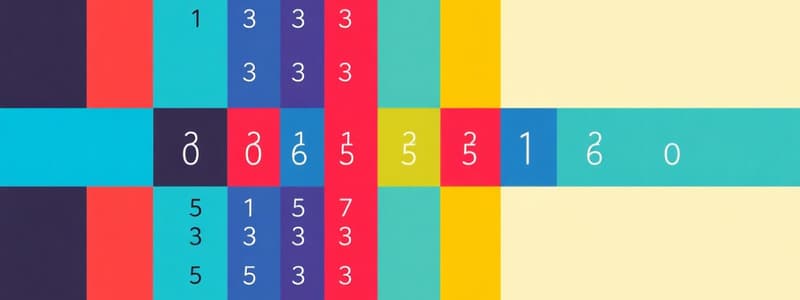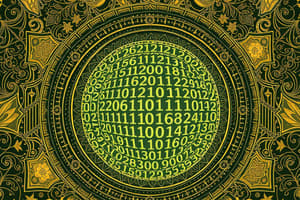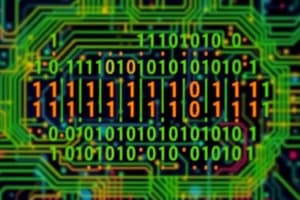Podcast
Questions and Answers
What is the primary function of a decoder in digital logic circuits?
What is the primary function of a decoder in digital logic circuits?
- To store binary data.
- To convert decoded input to coded output.
- To convert coded input to decoded output. (correct)
- To amplify digital signals.
In the context of binary decoders, what does 'n' represent in the expression $m = 2^n$?
In the context of binary decoders, what does 'n' represent in the expression $m = 2^n$?
- The total number of components in the circuit.
- The power consumption of the decoder.
- The number of input lines. (correct)
- The number of output lines.
Which of the following is a typical application of decoders in computer systems?
Which of the following is a typical application of decoders in computer systems?
- Memory addressing. (correct)
- Data encryption.
- Power supply regulation.
- Analog-to-digital conversion.
In a binary decoder, how many outputs are typically activated for each unique input combination?
In a binary decoder, how many outputs are typically activated for each unique input combination?
What is the function of the 'enable' input in a binary decoder?
What is the function of the 'enable' input in a binary decoder?
What is the key difference between 1D and 2D memory decoders?
What is the key difference between 1D and 2D memory decoders?
What is the purpose of a truth table in the context of binary decoders?
What is the purpose of a truth table in the context of binary decoders?
What is the purpose of using a decoder in display systems, such as 7-segment displays?
What is the purpose of using a decoder in display systems, such as 7-segment displays?
When is it necessary to modify a binary decoder circuit?
When is it necessary to modify a binary decoder circuit?
Which logic gate is predominantly used in the circuit diagram of a binary decoder to implement the logic equations?
Which logic gate is predominantly used in the circuit diagram of a binary decoder to implement the logic equations?
What is the relationship between the number of input lines (n) and the number of output lines (m) in a binary decoder??
What is the relationship between the number of input lines (n) and the number of output lines (m) in a binary decoder??
Which scenario would necessitate the use of an 'enable' input in a decoder circuit?
Which scenario would necessitate the use of an 'enable' input in a decoder circuit?
What is the primary advantage of using a 2D memory decoder compared to a 1D memory decoder in large memory systems?
What is the primary advantage of using a 2D memory decoder compared to a 1D memory decoder in large memory systems?
How does the inclusion of an 'enable' input modify the logic equations for a decoder's outputs?
How does the inclusion of an 'enable' input modify the logic equations for a decoder's outputs?
In a 3-to-8 binary decoder, which output line is activated when the input is A2=1, A1=0 and A0=1?
In a 3-to-8 binary decoder, which output line is activated when the input is A2=1, A1=0 and A0=1?
What is the significance of decoders in the context of instruction decoding within a CPU?
What is the significance of decoders in the context of instruction decoding within a CPU?
In memory systems, how does a decoder assist in the retrieval and storage of data at specific memory locations?
In memory systems, how does a decoder assist in the retrieval and storage of data at specific memory locations?
How is a 3-to-8 line decoder constructed using 2-to-4 line decoders and an additional logic gate?
How is a 3-to-8 line decoder constructed using 2-to-4 line decoders and an additional logic gate?
Design a 3-to-8 decoder using only 2-to-4 decoders and NOT gates. What is the minimum number of 2-to-4 decoders required?
Design a 3-to-8 decoder using only 2-to-4 decoders and NOT gates. What is the minimum number of 2-to-4 decoders required?
A combinational logic circuit has 4 inputs (A, B, C, D) and 16 outputs (O0 to O15). It is designed such that only one output is active (HIGH) for each unique combination of inputs. Which of the following best describes this circuit?
A combinational logic circuit has 4 inputs (A, B, C, D) and 16 outputs (O0 to O15). It is designed such that only one output is active (HIGH) for each unique combination of inputs. Which of the following best describes this circuit?
How would the output logic equations of a 2-to-4 decoder change if the decoder's outputs were active-low instead of active-high?
How would the output logic equations of a 2-to-4 decoder change if the decoder's outputs were active-low instead of active-high?
What impact does an 'enable' signal have on the overall functionality of a 3-to-8 decoder? Select all statements which are true.
What impact does an 'enable' signal have on the overall functionality of a 3-to-8 decoder? Select all statements which are true.
Consider a memory addressing system that utilizes a 3-to-8 decoder. Each output of the decoder selects a different memory bank. A faulty decoder always activates two output lines simultaneously. What issue would this cause?
Consider a memory addressing system that utilizes a 3-to-8 decoder. Each output of the decoder selects a different memory bank. A faulty decoder always activates two output lines simultaneously. What issue would this cause?
Which of the following is a DISADVANTAGE of using a 1D memory decoder?
Which of the following is a DISADVANTAGE of using a 1D memory decoder?
What is the logical expression for D1 of a 2-bit binary decoder?
What is the logical expression for D1 of a 2-bit binary decoder?
What is the logic equation for output $D_0$ in a 2-to-4 binary decoder, where $A_1$ and $A_0$ are inputs?
What is the logic equation for output $D_0$ in a 2-to-4 binary decoder, where $A_1$ and $A_0$ are inputs?
A 2-to-4 decoder is designed with an active-low enable input (E). Which of the following statements accurately describes its behavior?
A 2-to-4 decoder is designed with an active-low enable input (E). Which of the following statements accurately describes its behavior?
How many 2-to-4 decoders are required to construct a 4-to-16 decoder?
How many 2-to-4 decoders are required to construct a 4-to-16 decoder?
A 5-to-32 decoder is implemented using a combination of smaller decoders. What is a common configuration for such an implementation?
A 5-to-32 decoder is implemented using a combination of smaller decoders. What is a common configuration for such an implementation?
What is the total number of logic gates required to implement a 2-to-4 decoder using AND gates and inverters?
What is the total number of logic gates required to implement a 2-to-4 decoder using AND gates and inverters?
In a 3-to-8 decoder, if the inputs A2, A1, and A0 are connected to the binary representation of the number 6 (i.e., A2=1, A1=1, A0=0), which output line will be active (assuming active-high outputs)?
In a 3-to-8 decoder, if the inputs A2, A1, and A0 are connected to the binary representation of the number 6 (i.e., A2=1, A1=1, A0=0), which output line will be active (assuming active-high outputs)?
What is the main advantage of implementing a decoder using a decoder tree structure?
What is the main advantage of implementing a decoder using a decoder tree structure?
Why is the 'enable' input crucial when cascading multiple decoder ICs to create a larger decoder?
Why is the 'enable' input crucial when cascading multiple decoder ICs to create a larger decoder?
A 2-to-4 decoder has inputs A1 and A0. The ouputs are D0, D1, D2, D3. In what scenario is output D2 of a 2-to-4 decoder high?
A 2-to-4 decoder has inputs A1 and A0. The ouputs are D0, D1, D2, D3. In what scenario is output D2 of a 2-to-4 decoder high?
You are implementing a memory addressing system using a 3-to-8 decoder. However, you notice that whenever input combination (A2=1, A1=0, A0=0) is applied, both outputs D4 and D5 become active. What is the most likely cause of this issue?
You are implementing a memory addressing system using a 3-to-8 decoder. However, you notice that whenever input combination (A2=1, A1=0, A0=0) is applied, both outputs D4 and D5 become active. What is the most likely cause of this issue?
Consider building a 5-to-32 decoder from lower-order decoders. Assuming you have 2-to-4 decoders available, how could you minimize the total number of ICs used to achieve this?
Consider building a 5-to-32 decoder from lower-order decoders. Assuming you have 2-to-4 decoders available, how could you minimize the total number of ICs used to achieve this?
Flashcards
Decoder Definition
Decoder Definition
A combinational logic circuit that converts coded input to decoded output.
Binary Decoder
Binary Decoder
Converts an n-bit binary input code into m = 2^n output lines, activating only one output for each input combination.
Decoder Truth Table
Decoder Truth Table
A table showing the relationship between inputs and outputs of a binary decoder.
Decoders in Memory Addressing
Decoders in Memory Addressing
Used in memory systems to select specific memory cells based on address lines.
Signup and view all the flashcards
Decoders in Display Systems
Decoders in Display Systems
Used to convert binary inputs into signals that light up specific segments to display numbers or characters.
Signup and view all the flashcards
Decoders in Control Logic
Decoders in Control Logic
Help in generating control signals for various parts of a digital system based on binary inputs.
Signup and view all the flashcards
Decoder 'Enable'
Decoder 'Enable'
A control signal that determines whether the decoder is active or inactive, acting as a switch to turn the decoder ON or OFF.
Signup and view all the flashcards
1D vs 2D Decoders
1D vs 2D Decoders
1D decoders are simpler but less scalable, while 2D decoders are more efficient for large memory systems.
Signup and view all the flashcardsStudy Notes
Decoder
- A combinational logic circuit converts coded input to decoded output.
- Decodes encoded data, activating specific output lines based on binary input.
Applications
- Used for memory addressing, display systems, and control logic in digital systems
Binary Decoder
- Converts an n-bit binary input code into m = 2^n output lines.
- Each output is activated for only one possible combination of inputs.
- Are designed to activate only one output per input, and activating multiple outputs requires modifications to the circuit.
Binary Decoder Truth Table
- The truth table is setup for a 2 input decoder
- For each input code, only one output (diagonal) is high (1).
Binary Decoder: Truth Table and Logic Equations
- If inputs A1 and A0 are both 0; then output D0 is 1
- If A1 is 0 and A0 is 1; then output D1 is 1
- If A1 is 1 and A0 is 0; then output D2 is 1
- If A1 and A0 are both 1; then output D3 is 1
- Do = Ā1 Ā0
- D1 = Ā1 A0
- D2 = A1 Ā0
- D3 = A1 A0
3-8 Binary Decoder Truth Table
- The truth table is setup for a 3-8 decoder that takes inputs A2, A1, A0 converts these into outputs D7, D6, D5, D4, D3, D2, D1, D0
3-8 Binary Decoder Logic Equations
- D0 = Ā2Ā1Ā0
- D1 = Ā2Ā1A0
- D2 = Ā2A1Ā0
- D3 = Ā2A1A0
- D4 = A2Ā1Ā0
- D5 = A2Ā1A0
- D6 = A2A1Ā0
- D7 = A2A1A0
Enable in a Binary Decoder
- Sometimes a decoder needs to be disabled.
- The enable is a control signal that determines whether the decoder is active or inactive.
- It acts as a "switch" to turn the decoder's functionality ON or OFF.
- Allows for better control and integration of the decoder in larger circuits.
Decoder with Enable Truth Table & Logic Equations
-
The truth table is setup for a 3 input decoder taking E, A1, A0 and converts this to D3, D2, D1, D0
-
Do = E Ā1 Ā0
-
D1 = E Ā1 A0
-
D2 = E A1 Ā0
-
D3 = E A1 A0
-
If E = 1, the decoder is enabled. If E = 0, the decoder is disabled.
Applications of Decoders
- Memory Addressing: Used to select specific memory cells or chips based on address lines. Ex: A 3-to-8 decoder can select one of 8 memory chips using 3 address lines.
- Display Systems: Used in 7-segment displays to convert binary inputs into signals that light up specific segments to display numbers or characters.
- Control Logic: Used in generating control signals for various parts of a digital system based on binary inputs.
- Instruction Decoding in CPUs: Used in microprocessors, decoders interpret binary instructions to activate specific control signals for executing operations.
- Combinational Logic Circuits: Used to implement complex logic functions by activating specific outputs based on input combinations.
1D Memory-Decoder
- In reference to memory, the data for address bus flows down to a 2-4 decoder
2D Memory-Decoder
-
In reference to memory, the data for address bus flows both to a first demux, and second demux to process
-
1D Decoders are simpler but less scalable, while 2D Decoders allow split addressing into rows and columns, and are more efficient for large memory systems.
A Decoder Tree
- A 3-8 line decoder that uses 2-4 line decoders, with multiple outputs
Studying That Suits You
Use AI to generate personalized quizzes and flashcards to suit your learning preferences.



